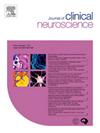Effect of primary patient language on large-vessel occlusive stroke treatment and functional outcomes
IF 1.9
4区 医学
Q3 CLINICAL NEUROLOGY
引用次数: 0
Abstract
Background and purpose
Patients with limited English proficiency may face barriers to acute ischemic stroke (AIS) care. This study investigates whether medical interpreter requirement for AIS patients affects access to endovascular therapy (EVT) or outcomes.
Methods
Retrospective review of an AIS database at a single comprehensive stroke center from 1/2021–12/2021 was conducted. Patient demographics, baseline and post-treatment AIS parameters were recorded. Patients were grouped by interpreter requirement. A propensity-matched cohort for interpreter requirement was created matching for age, presenting National Institute of Health Stroke Scale (NIHSS), occlusion site and side, thrombolytic treatment, and EVT. Primary outcomes included discharge NIHSS and modified Rankin score (mRS), and 90-day mRS. Secondary outcomes included NIHSS shift from presentation to discharge.
Results
Among 355 included patients, 321 (90.4 %) spoke English. English speakers were more likely to identify as white (85.6 % vs 38.2 %, p < 0.001). Non-English speakers presented with higher NIHSS (median 21 [IQR 15–24] vs. 14 [6–20], p < 0.001). Rates of thrombolytic administration (41.7 % vs 20.9 %) or EVT (61.8 % vs. 66.0 %) were similar between groups. Among thrombectomy patients, the times from hospital arrival to device deployment or recanalization were not significantly different by language group. Discharge mRS (5 [4–5] vs. 4 [3–5], p = 0.023) and NIHSS (9 [1–19] vs. 3 [1–12], p = 0.026) were higher for non-English speakers. There was no significant difference in NIHSS shift or the rate of 90-day mRS 0–2 (23.5 % vs 34.3 %). The propensity-matched cohort included 30 patients in each group and demonstrated higher premorbid and discharge mRS, and admission and discharge NIHSS for non-English speakers (p < 0.019).
Conclusions
Non-English speaking AIS patients present with more severe symptoms and are discharged with poorer reported neurological function despite receiving similar treatments to English speakers.
Patients with limited English proficiency may face barriers to acute ischemic stroke (AIS) care. This study investigates whether medical interpreter requirement for AIS patients affects access to endovascular therapy (EVT) or outcomes. Retrospective review of an AIS database at a single comprehensive stroke center from 1/2021–12/2021 was conducted. Patients were grouped by interpreter requirement. A propensity-matched cohort for interpreter requirement was created matching for age, presenting National Institute of Health Stroke Scale (NIHSS), occlusion site and side, thrombolytic treatment, and EVT. Primary outcomes included discharge NIHSS and modified Rankin score (mRS), and 90-day mRS. Secondary outcomes included NIHSS shift from presentation to discharge. Among 355 included patients, 321 (90.4 %) spoke English. English speakers were more likely to identify as white (85.6 % vs 38.2 %, p < 0.001). Non-English speakers presented with higher NIHSS (median 21 [IQR 15–24] vs. 14 [6–20], p < 0.001). Rates of thrombolytic administration (41.7 % vs 20.9 %) or EVT (61.8 % vs. 66.0 %) were similar between groups. Discharge mRS (5 [4–5] vs. 4 [3–5], p = 0.023) and NIHSS (9 [1–19] vs. 3 [1–12], p = 0.026) were higher for non-English speakers. There was no significant difference in NIHSS shift or the rate of 90-day mRS 0–2 (23.5 % vs 34.3 %). The propensity-matched cohort included 30 patients in each group and demonstrated higher premorbid and discharge mRS, and admission and discharge NIHSS for non-English speakers (p < 0.019). Non-English speaking AIS patients present with more severe symptoms and are discharged with poorer reported neurological function despite receiving similar treatments to English speakers.
原发性患者语言对大血管闭塞性卒中治疗和功能结局的影响
背景和目的英语水平有限的患者可能面临急性缺血性卒中(AIS)护理的障碍。本研究探讨AIS患者的医学翻译需求是否会影响血管内治疗(EVT)的获得或结果。方法回顾性分析某脑卒中综合中心2021年1月至2021年12月AIS数据库。记录患者人口统计学、基线和治疗后AIS参数。患者按译员要求分组。根据年龄、美国国立卫生研究院卒中量表(NIHSS)、闭塞部位和侧边、溶栓治疗和EVT建立口译需求倾向匹配队列。主要结局包括出院NIHSS、改良Rankin评分(mRS)和90天mRS。次要结局包括NIHSS从就诊到出院的转变。结果355例患者中,321例(90.4%)说英语。说英语的人更有可能被认为是白人(85.6%对38.2%,p <;0.001)。非英语人士表现出更高的NIHSS(中位数21 [IQR 15-24]对14 [6-20],p <;0.001)。溶栓给药率(41.7% vs 20.9%)或EVT (61.8% vs 66.0%)在两组之间相似。在取栓患者中,从到达医院到装置部署或再通的时间在语言组间无显著差异。非英语者的放电mRS(5[4 - 5]比4 [3 - 5],p = 0.023)和NIHSS(9[1-19]比3 [1-12],p = 0.026)更高。NIHSS转移或90天mRS 0-2的比率无显著差异(23.5% vs 34.3%)。倾向匹配队列包括每组30例患者,显示出较高的发病前和出院前mRS,非英语人士入院和出院时NIHSS (p <;0.019)。结论非英语AIS患者的症状更严重,出院时报告的神经功能较差,尽管接受了与英语患者相似的治疗。英语水平有限的患者可能面临急性缺血性卒中(AIS)护理的障碍。本研究探讨AIS患者的医学翻译需求是否会影响血管内治疗(EVT)的获得或结果。回顾性分析了2021年1月至2021年12月在单一综合卒中中心的AIS数据库。患者按译员要求分组。根据年龄、美国国立卫生研究院卒中量表(NIHSS)、闭塞部位和侧边、溶栓治疗和EVT建立口译需求倾向匹配队列。主要结局包括出院NIHSS、改良Rankin评分(mRS)和90天mRS。次要结局包括NIHSS从就诊到出院的转变。在355例纳入的患者中,321例(90.4%)说英语。说英语的人更有可能被认为是白人(85.6%对38.2%,p <;0.001)。非英语人士表现出更高的NIHSS(中位数21 [IQR 15-24]对14 [6-20],p <;0.001)。溶栓给药率(41.7% vs 20.9%)或EVT (61.8% vs 66.0%)在两组之间相似。非英语者的放电mRS(5[4 - 5]比4 [3 - 5],p = 0.023)和NIHSS(9[1-19]比3 [1-12],p = 0.026)更高。NIHSS转移或90天mRS 0-2的比率无显著差异(23.5% vs 34.3%)。倾向匹配队列包括每组30例患者,显示出较高的发病前和出院前mRS,非英语人士入院和出院时NIHSS (p <;0.019)。非英语AIS患者表现出更严重的症状,出院时报告的神经功能较差,尽管接受了与英语患者相似的治疗。
本文章由计算机程序翻译,如有差异,请以英文原文为准。
求助全文
约1分钟内获得全文
求助全文
来源期刊

Journal of Clinical Neuroscience
医学-临床神经学
CiteScore
4.50
自引率
0.00%
发文量
402
审稿时长
40 days
期刊介绍:
This International journal, Journal of Clinical Neuroscience, publishes articles on clinical neurosurgery and neurology and the related neurosciences such as neuro-pathology, neuro-radiology, neuro-ophthalmology and neuro-physiology.
The journal has a broad International perspective, and emphasises the advances occurring in Asia, the Pacific Rim region, Europe and North America. The Journal acts as a focus for publication of major clinical and laboratory research, as well as publishing solicited manuscripts on specific subjects from experts, case reports and other information of interest to clinicians working in the clinical neurosciences.
 求助内容:
求助内容: 应助结果提醒方式:
应助结果提醒方式:


